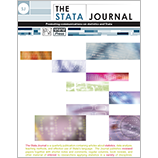dhreg, xtdhreg, and bootdhreg: Commands to implement double-hurdle regression
Christoph Engel
Max Planck Institute for Research
on Collective Goods
Bonn, Germany
[email protected]
|
Peter G. Moffatt
School of Economics
University of East Anglia
Norwich, UK
[email protected]
|
Abstract. The dhreg command implements maximum likelihood estimation of
the double-hurdle model for continuously distributed outcomes. The command
includes the option to fit a p-tobit model, that is, a model that estimates only an
intercept for the hurdle equation. The bootdhreg command (the bootstrap version
of dhreg) may be convenient if the data-generating process is more complicated
or if heteroskedasticity is suspected. The xtdhreg command is a random-effects
version of dhreg applicable to panel data. However, this estimator differs from
standard random-effects estimators in the sense that the outcome of the first hurdle
applies to the complete set of observations for a given subject instead of applying
at the level of individual observations. Command options include estimation of a
correlation parameter capturing dependence between the two hurdles.
View all articles by these authors:
Christoph Engel, Peter G. Moffatt
View all articles with these keywords:
dhreg, xtdhreg, bootdhreg, hurdle model, double-hurdle model, random-effects double-hurdle model, tobit, p-tobit, inverse Mills ratio, bootstrapping
Download citation: BibTeX RIS
Download citation and abstract: BibTeX RIS
|
